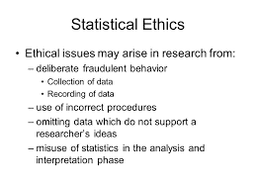
Ethics and other issues with experiments
Quiz by Joseph Chatlos
Feel free to use or edit a copy
includes Teacher and Student dashboards
Measure skillsfrom any curriculum
Measure skills
from any curriculum
Tag the questions with any skills you have. Your dashboard will track each student's mastery of each skill.
With a free account, teachers can
- edit the questions
- save a copy for later
- start a class game
- automatically assign follow-up activities based on students’ scores
- assign as homework
- share a link with colleagues
- print as a bubble sheet
20 questions
Show answers
- Q1What is not an effective experimental design?A single treatment study.Matched pairs, blocking on one factor.Completely randomized.Matched pairs, where subjects are their own controls.60s
- Q2We have three explanatory variables in a study, with 2, 4, and 5 levels, respectively. We can make ____ treatments for this study.1330401160s
- Q3In the haunted house study, list the treatments.Scary house, gross house, non-haunted house.Scary house, gross house.Haunted house, non-haunted house.People who like haunted houses.60s
- Q4In the haunted houses study, when completely randomized, how many houses will each person see?012360s
- Q5In the completely randomized houses study, what blindness can we have?Double blindnessTriple blindnessNo blindnessSingle blindness60s
- Q6In the completely randomized haunted houses study, what best describes control?The controls do not visit a haunted house.The controls visit a placebo haunted house.The controls visit an ordinary, non-haunted house.No control; we only compare two treatments to see which people like better.60s
- Q7A matched pairs design, blocking on age, has 400 participants. How many groups do we make?400 groups.200 groups.2 groups.100 groups.60s
- Q8In matched pairs blocking on age, how many houses does each person see?0 houses.1 house.2 houses.3 houses.60s
- Q9What are the advantage(s) of matched pairs, blocking on age, over a completely randomized design?We get more people in the study.We see which haunted house every person likes better.We make sure people don't go crazy and wreck the haunted houses.We prevent age from confounding the results. We also can make different conclusions for different ages60s
- Q10In matched pairs, where people are their own controls, how many haunted houses does each person see?Both houses (2 houses).3 houses.1 house.0 houses.60s
- Q11In matched pairs, where subjects are their own controls, what is correct?We make people choose which house they go through.We let people decide which house they go through first.We send everyone through the same house first, and then through the other.We randomly decide which house each person sees first.60s
- Q12What is an advantage of matched pairs, where subjects are their own controls?We see which house each person likes best.The experiment takes less time.The experiment costs less.We can use two levels of randomization.60s
- Q13We test the effect of illicit drug use during pregnancy on the health of babies in their first month of life. What is the problem with this experiment?The experiment will take too long.The experiment will be too expensive.Babies are all different, so this affects the results.We cannot assign some mothers to use drugs during pregnancy.60s
- Q14Describe the problem with a designed experiment in the surgery example.People might want both surgeries.We cannot ethically perform a placebo surgery.People react differently to surgery.We cannot perform surgery in an experiment.60s
- Q15What is a placebo in an experiment?We divide subjects into groups by chance.A false treatment that looks, tastes, and smells like the real treatment.Subjects and evaluators do not know their treatments.The real treatment in an experiment.60s